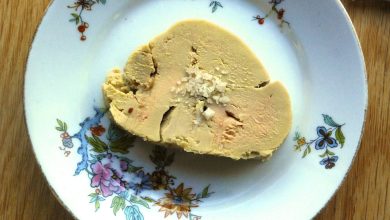Fresh Bluefin Tuna (Raw) – Nutritional Information & Ingredients
Fresh bluefin tuna, served raw, is a highly prized fish known for its rich flavor, delicate texture, and remarkable nutritional profile. Often featured in sushi, sashimi, or as a standalone dish, it is a versatile and premium ingredient loved by seafood enthusiasts around the world. Bluefin tuna, with its vibrant red flesh, is an excellent source of lean protein, healthy fats, and a range of essential vitamins and minerals.
Below, we provide detailed nutritional information and health benefits of fresh bluefin tuna to help you make informed choices while enjoying this exquisite seafood:
Ingredients Information
Fresh bluefin tuna (raw)
Nutritional Information (Per 100g of Fresh Bluefin Tuna)
| Nutrient | Amount per 100g |
|---|---|
| Energy | 144 kcal |
| Protein | 23.33 g |
| Fat | 4.9 g |
| Saturated Fats | 1.257 g |
| Carbohydrates | 0.0 g |
| Fiber | 0.0 g |
| Sugar | 0.0 g |
| Calcium | 8 mg |
| Iron | 1.02 mg |
| Magnesium | 50 mg |
| Phosphorus | 254 mg |
| Potassium | 252 mg |
| Sodium | 39 mg |
| Zinc | 0.6 mg |
| Copper | 0.086 mcg |
| Manganese | 0.015 mg |
| Selenium | 36.5 mcg |
| Vitamin C | 0.0 mg |
| Thiamine (B1) | 0.241 mg |
| Riboflavin (B2) | 0.251 mg |
| Niacin (B3) | 8.654 mg |
| Vitamin B6 | 0.455 mg |
| Folate | 2.0 mcg |
| Vitamin B12 | 9.43 mcg |
| Vitamin A | 655 mcg |
| Vitamin E | 1 mg |
| Vitamin D2 | 5.7 mcg |
Allergen Information
Fresh bluefin tuna is a high-quality, low-allergen food, but it should be noted that, like all seafood, it can cause allergic reactions in individuals who are sensitive to fish or seafood. Symptoms of a fish allergy may include hives, swelling, difficulty breathing, and anaphylaxis in severe cases. Always check with your guests or diners for food allergies before serving bluefin tuna.
Note: As this is raw tuna, there is a risk of foodborne illness. It is important to source the tuna from a reputable supplier to ensure it is handled and stored safely. Pregnant women, young children, elderly individuals, and people with weakened immune systems should avoid raw fish to reduce health risks.
Dietary Preferences
Fresh bluefin tuna is a rich source of high-quality protein and essential fats, making it suitable for a variety of dietary preferences:
- Low-Carb / Keto: With zero carbohydrates, bluefin tuna is an excellent choice for those following a low-carb or ketogenic diet.
- Paleo: Bluefin tuna fits well into a paleo diet, as it is a natural, unprocessed food that aligns with the principles of whole, nutrient-dense eating.
- Gluten-Free: Naturally gluten-free, bluefin tuna is a great option for those with celiac disease or gluten sensitivity.
- High-Protein: For those aiming to increase their protein intake, bluefin tuna provides a significant amount of protein per serving, supporting muscle growth and repair.
- Heart-Healthy: Bluefin tuna contains healthy fats, including omega-3 fatty acids, which are beneficial for cardiovascular health.
Health Benefits of Fresh Bluefin Tuna
-
High-Quality Protein: Bluefin tuna is an excellent source of lean, easily digestible protein, supporting muscle growth, repair, and overall body function.
-
Rich in Omega-3 Fatty Acids: These essential fats are known for their heart-healthy properties, reducing inflammation and supporting brain function. Consuming omega-3s can help improve cholesterol levels, reduce blood pressure, and lower the risk of heart disease.
-
Rich in Vitamins: Bluefin tuna provides a wealth of vitamins, including Vitamin A (important for vision and immune health) and Vitamin B12 (which plays a key role in red blood cell production and nervous system health).
-
Mineral-Rich: Bluefin tuna is a good source of essential minerals like magnesium, phosphorus, and potassium, which are important for bone health, nerve function, and hydration balance.
-
Boosts Metabolism: The niacin (Vitamin B3) content in bluefin tuna helps in energy production and maintaining a healthy metabolism.
-
Immune System Support: The selenium content in bluefin tuna supports the immune system and acts as an antioxidant, protecting the body against oxidative stress and inflammation.
-
Weight Management: Low in carbohydrates and high in protein, bluefin tuna can aid in satiety, making it a great option for those looking to manage or reduce their weight.
Cooking and Serving Tips
- Sushi and Sashimi: Bluefin tuna is famously used for sushi and sashimi. For these dishes, ensure that the fish is extremely fresh and has been properly handled to reduce any risk of contamination.
- Grilling: If you prefer to cook your tuna, grilling is a popular option. Lightly season the tuna and grill it on high heat for just a few minutes on each side to retain its moisture and flavor.
- Seared Tuna: A seared tuna steak is another excellent way to enjoy this fish. Sear it quickly in a hot pan, leaving the inside rare, for a rich and tender texture.
- Tuna Tartare: A fresh and light preparation, tuna tartare is made by finely dicing raw tuna and mixing it with ingredients like avocado, sesame oil, and soy sauce.
Conclusion
Fresh bluefin tuna is not just a delicacy; it’s a powerhouse of nutrition. Packed with high-quality protein, heart-healthy omega-3 fatty acids, and essential vitamins and minerals, it makes an excellent choice for a wide variety of diets. Whether you’re serving it raw as sushi, lightly seared, or in a tartare, this versatile fish offers a burst of flavor and a wealth of health benefits.
Always ensure that your tuna is sourced from a trusted supplier and handled with care to maintain its freshness and safety. Enjoy this exquisite seafood as part of a balanced diet and indulge in its unmatched taste and texture.










